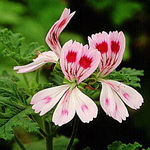| Common Name: |
Pelargonium 'Fair Ellen' |
| Botanical Name: |
Pelargonium x. fair ellen |
| Genus: |
Pelargonium |
| Family: |
Geraniaceae |
| Cultivation: |
Well-drained, neutral to alkaline soil in sun. Pelargonium crispum, P. odoratissimum, and P. tomentosum tolerate partial shade. Plants may be cut back in early spring. If grown outdoors in cool climates, they may also be cut back before bringing in for the winter. Leafhoppers, aphids, spider mites, and whitefly may attack plants under cover. |
| Propagation: |
By softwood cuttings in spring, late summer, or early autumn. |
| Harvest: |
Plants are cut in late summer and distilled for oil. Leaves are picked as required. |
| Height: |
30-60cm (12-24in) |
| :Width |
60-90cm (24-36in) |
| Hardiness: |
Min. 2°C (36°F) |
| Parts Used: |
Leaves |
| Properties: |
An aromatic herb with a balsam-like scent. |
| Economic Uses: |
Mainly grown as an aromatic ornamental. Leaves may be dried for potpourris. |
| Bibliography: |
Encylopedia of Herbs by Deni Brown Copyright ©: 1995, 2001 Dorling Kindersley Limited pg.304-306
|

